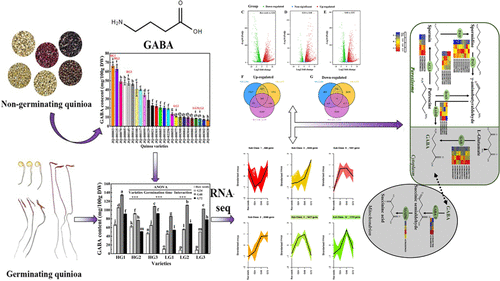当前位置:
X-MOL 学术
›
J. Agric. Food Chem.
›
论文详情
Our official English website, www.x-mol.net, welcomes your feedback! (Note: you will need to create a separate account there.)
Transcriptome Analysis Reveals the Molecular Mechanism of GABA Accumulation during Quinoa (Chenopodium quinoa Willd.) Germination
Journal of Agricultural and Food Chemistry ( IF 6.1 ) Pub Date : 2021-10-05 , DOI: 10.1021/acs.jafc.1c02933 Derui Zhang 1 , Xiaonan Wei 1 , Ze Liu 1 , Xiangyun Wu 2 , Changjian Bao 1 , Yuzhe Sun 3 , Nana Su 1 , Jin Cui 1
Journal of Agricultural and Food Chemistry ( IF 6.1 ) Pub Date : 2021-10-05 , DOI: 10.1021/acs.jafc.1c02933 Derui Zhang 1 , Xiaonan Wei 1 , Ze Liu 1 , Xiangyun Wu 2 , Changjian Bao 1 , Yuzhe Sun 3 , Nana Su 1 , Jin Cui 1
Affiliation

|
Quinoa (Chenopodium quinoa Willd.) with a history of 5000 years as food is extremely rich in nutrients and bioactive compounds, including γ-aminobutyric acid (GABA), a natural four-carbon non-protein amino acid with great benefits to human health. In quinoa, GABA generally increases with the germination time, but the underlying molecular mechanism is unclear. Here, we found that the GABA content in quinoa varied significantly among 25 varieties using an automatic amino acid analyzer. Next, six varieties (three low-GABA and three high-GABA varieties) were used for further analyses. The content of GABA in six varieties all showed an increasing trend after germination. In addition, Pearson’s correlation analysis showed that the changes in GABA content were closely related to the transcript level or enzyme activity of three key enzymes including glutamate decarboxylase (GAD), GABA transaminase (GABA-T), and succinate-semialdehyde dehydrogenase (SSADH) in the GABA shunt, especially GAD. Based on RNA-sequencing analysis, eight GAD genes, two GABA-T genes, one SSADH gene, nine polyamine oxidase (PAO) genes, five diamine oxidase (DAO) genes, four 4-aminobutyraldehyde dehydrogenase (BADH) genes, and three thermospermine synthase ACAULIS5 (ACL5) genes were identified. Among these, CqGAD8 and CqGABA-T2 may make a greater contribution to GABA accumulation during quinoa germination.
中文翻译:

转录组分析揭示藜麦 (Chenopodium quinoa Willd.) 萌发过程中 GABA 积累的分子机制
藜麦(Chenopodium quinoaWilld.) 有 5000 年的历史,因为食物中含有极其丰富的营养成分和生物活性化合物,其中包括 γ-氨基丁酸 (GABA),一种对人体健康有很大益处的天然四碳非蛋白质氨基酸。在藜麦中,GABA 通常随着发芽时间的增加而增加,但潜在的分子机制尚不清楚。在这里,我们使用自动氨基酸分析仪发现,藜麦中 GABA 含量在 25 个品种之间存在显着差异。接下来,六个品种(三个低 GABA 和三个高 GABA 品种)用于进一步分析。6个品种的GABA含量在发芽后均呈上升趋势。此外,Pearson 相关性分析表明,GABA 含量的变化与谷氨酸脱羧酶(GAD)、GABA 转氨酶 (GABA-T) 和琥珀酸半醛脱氢酶 (SSADH) 在 GABA 分流中,尤其是 GAD。基于 RNA 测序分析,八GAD基因、2 个GABA - T基因、1 个SSADH基因、9 个多胺氧化酶 ( PAO ) 基因、5 个二胺氧化酶 ( DAO ) 基因、4 个 4-氨基丁醛脱氢酶 ( BADH ) 基因和 3 个热精胺合酶 ACAULIS5 ( ACL 5) 基因确定。其中,CqGAD 8 和CqGABA - T 2 可能对藜麦萌发过程中GABA的积累有更大的贡献。
更新日期:2021-10-20
中文翻译:

转录组分析揭示藜麦 (Chenopodium quinoa Willd.) 萌发过程中 GABA 积累的分子机制
藜麦(Chenopodium quinoaWilld.) 有 5000 年的历史,因为食物中含有极其丰富的营养成分和生物活性化合物,其中包括 γ-氨基丁酸 (GABA),一种对人体健康有很大益处的天然四碳非蛋白质氨基酸。在藜麦中,GABA 通常随着发芽时间的增加而增加,但潜在的分子机制尚不清楚。在这里,我们使用自动氨基酸分析仪发现,藜麦中 GABA 含量在 25 个品种之间存在显着差异。接下来,六个品种(三个低 GABA 和三个高 GABA 品种)用于进一步分析。6个品种的GABA含量在发芽后均呈上升趋势。此外,Pearson 相关性分析表明,GABA 含量的变化与谷氨酸脱羧酶(GAD)、GABA 转氨酶 (GABA-T) 和琥珀酸半醛脱氢酶 (SSADH) 在 GABA 分流中,尤其是 GAD。基于 RNA 测序分析,八GAD基因、2 个GABA - T基因、1 个SSADH基因、9 个多胺氧化酶 ( PAO ) 基因、5 个二胺氧化酶 ( DAO ) 基因、4 个 4-氨基丁醛脱氢酶 ( BADH ) 基因和 3 个热精胺合酶 ACAULIS5 ( ACL 5) 基因确定。其中,CqGAD 8 和CqGABA - T 2 可能对藜麦萌发过程中GABA的积累有更大的贡献。



























 京公网安备 11010802027423号
京公网安备 11010802027423号